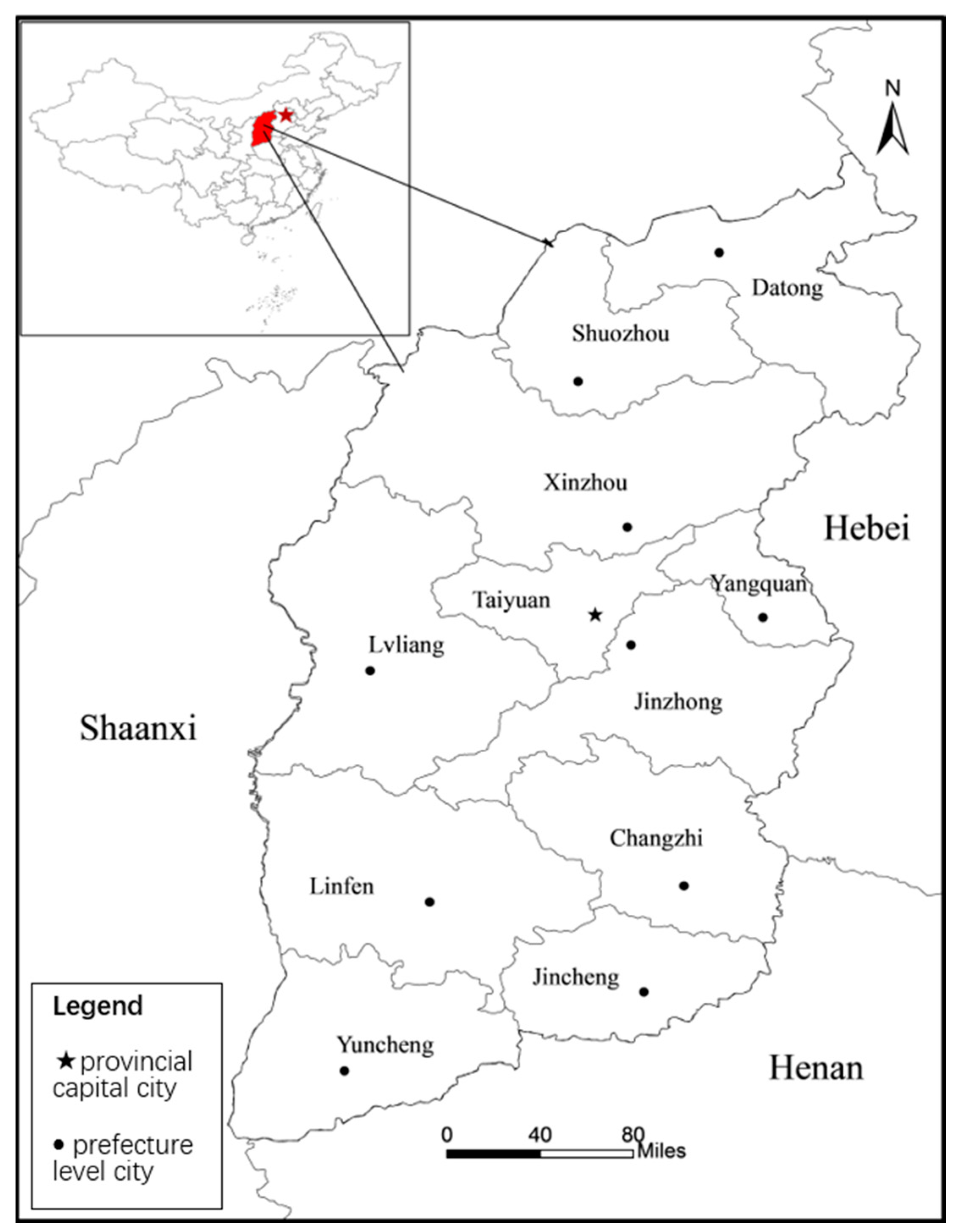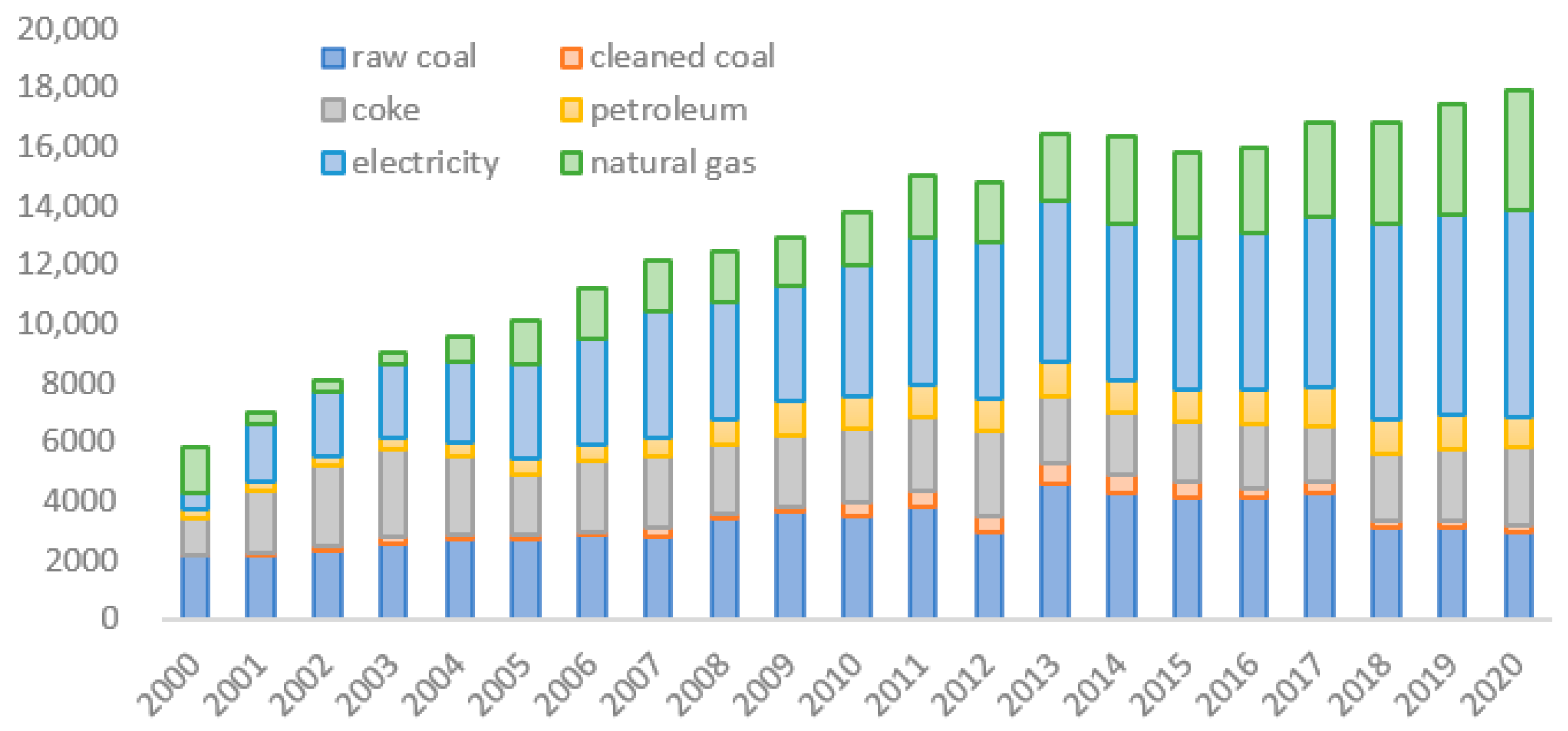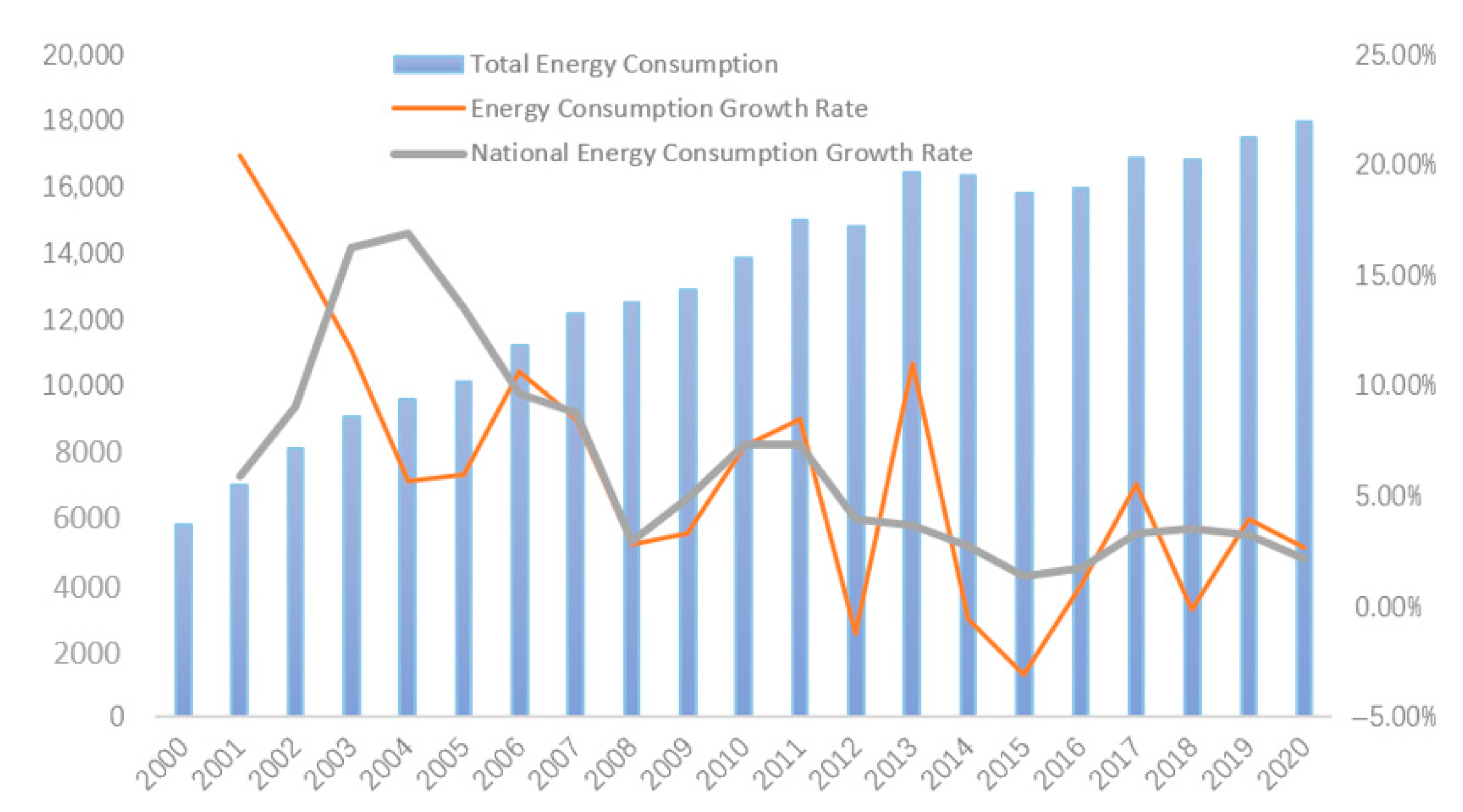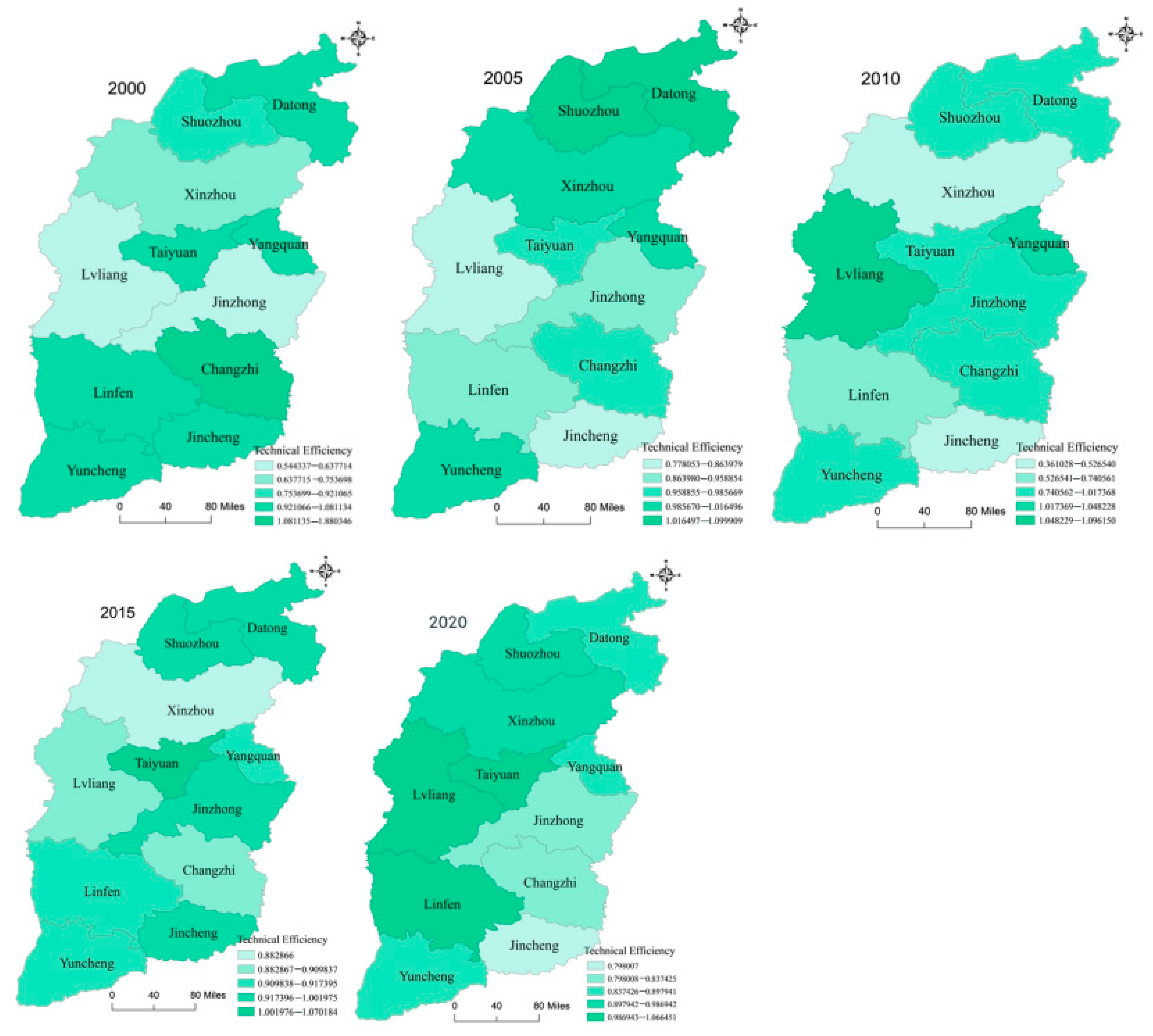Carbon Emission Efficiency and Low-Carbon Optimization in Shanxi Province under “Dual Carbon” Background
Abstract
:1. Introduction
2. Overview of the Study Area
3. Research Methods
3.1. IPCC Method
3.2. DEA Model
3.3. Malmquist Index Model
4. Results
4.1. Energy Consumption in Shanxi Province
4.1.1. Energy Consumption Structure
4.1.2. Changes in Energy Consumption
4.2. Analysis of Carbon Emissions in Shanxi Province
4.2.1. Index System
4.2.2. Carbon Emissions Efficiency of Shanxi Province
4.2.3. Carbon Emission Efficiency of 11 Prefecture-Level Cities
4.2.4. Spatial-Temporal Differentiation of Carbon Emission Efficiency in Shanxi Province
5. Conclusions and Suggestions
Author Contributions
Funding
Institutional Review Board Statement
Informed Consent Statement
Data Availability Statement
Conflicts of Interest
References
- Kisielińska, J.; Roman, M.; Pietrzak, P.; Roman, M.; Łukasiewicz, K.; Kacperska, E. Utilization of Renewable Energy Sources in Road Transport in EU Countries—TOPSIS Results. Energies 2021, 14, 7457. [Google Scholar] [CrossRef]
- Lee, R. The outlook for population growth. Science 2011, 333, 569–573. [Google Scholar] [CrossRef] [PubMed] [Green Version]
- Sharif, A.; Godil, D.I.; Xu, B.; Sinha, A.; Khan, S.A.R.; Jermsittiparsert, K. Revisiting the role of tourism and globalization in environmental degradation in China: Fresh insights from the quantile ARDL approach. J. Clean. Prod. 2020, 272, 122906. [Google Scholar] [CrossRef]
- Nerini, F.F.; Sovacool, B.; Hughes, N.; Cozzi, L.; Cosgrave, E.; Howells, M.; Tavoni, M.; Tomei, J.; Zerriffi, H.; Milligan, B. Connecting climate action with other Sustainable Development Goals. Nat. Sustain. 2019, 2, 674–680. [Google Scholar] [CrossRef]
- Alam, M.M.; Murad, M.W.; Noman, A.H.M.; Ozturk, I. Relationships among carbon emissions, economic growth, energy consumption and population growth: Testing Environmental Kuznets Curve hypothesis for Brazil, China, India and Indonesia. Ecol. Indic. 2016, 70, 466–479. [Google Scholar] [CrossRef]
- Liu, C.L. Definition, connotation and related concepts of low carbon economy. Commer. Times 2011, 21, 10–11. [Google Scholar]
- Zhuang, G.Y.; Dou, X.M.; Wei, M.X. Theoretical Interpretation and Path Analysis of Carbon Neutralization in Carbon Peaks. J. Lanzhou Univ. 2022, 50, 57–68. [Google Scholar]
- Jia, K. Carbon peak and carbon neutrality: The inevitable choice and problem solving of high-quality development. J. Int. Financ. 2021, 11, 3–6. [Google Scholar]
- Fang, S.J.; Zhu, Y.F. Analysis of energy economic development from the perspective of ’carbon peak’ and ’carbon neutralization’. J/OL. Xinjiang Norm. Univ. 2022, 3, 1–10. [Google Scholar]
- Opinions of the Central Committee of the Communist Party of China and the State Council on the Complete and Accurate Implementation of the New Development Concept to Do a Good Job of Carbon Peak Carbon Neutralization Released. Available online: https://kns.cnki.net/kcms/detail/detail.aspx?dbcode=CJFD&dbname=CJFDLAST2022&filename=GTJJ202111005&uniplatform=NZKPT&v=nxtAgOdjGvFcTO2tvUhbAPyebzot5tZ4YSpeI8R3UGVZ9x-CLOYd1tLvLRQL03nH (accessed on 1 January 2022).
- Guidance on Accelerating the Establishment and Improvement of a Green and Low-Carbon Cycle economic System. Available online: http://www.gov.cn/zhengce/content/2021-02/22/content_5588274.htm (accessed on 1 January 2022).
- Wang, B. The era requirements, strategic objectives and international governance experience of the national strategy for ecological protection and high-quality development in the Yellow River Basin. J. Yunnan Adm. Coll. 2021, 6, 149–161. [Google Scholar]
- Chong, C.T.; Van, F.Y.; Tin, L.C.; Jaromír, K.J. Post COVID-19 ENERGY sustainability and carbon emissions neutrality. Energy 2022, 241, 122801. [Google Scholar] [CrossRef]
- Bamadev, M.; Mohd, I. Asymmetric impacts of energy efficiency on carbon emissions: A comparative analysis between developed and developing economies. Energy 2021, 227, 120485. [Google Scholar] [CrossRef]
- Godil, D.I.; Yu, Z.; Sharif, A.; Usman, R.; Khan, S.A.R. Investigate the role of technology innovation and renewable energy in reducing transport sector CO2 emission in China: A path toward sustainable development. Sustain. Dev. 2021, 29, 694–707. [Google Scholar] [CrossRef]
- Adeolu, O.; Adewuyi, O.B. Awodumi. Biomass energy consumption, economic growth and carbon emissions: Fresh evidence from West Africa using a simultaneous equation model. Energy 2017, 119, 453–471. [Google Scholar] [CrossRef]
- Ramanathan, R. A multi-factor efficiency perspective to the relationships among world GDP, energy consumption and carbon dioxide emissions. Technol. Forecast. Soc. Chang. 2005, 73, 483–494. [Google Scholar] [CrossRef]
- Ding, L.L.; Lei, L.; Zhao, X.; Calin, A.C. Modelling energy and carbon emission performance: A constrained performance index measure. Energy 2020, 197, 117274. [Google Scholar] [CrossRef]
- Yang, X.Y.; Li, N.; Mu, H.L.; Pang, J.R.; Zhao, H.; Mahmood, A. Study on the long-term impact of economic globalization and population aging on CO2 emissions in OECD countries. Sci. Total Environ. 2021, 787, 147625. [Google Scholar] [CrossRef]
- Wu, R.; Wang, J.Y.; Wang, S.J.; Feng, K.H. The drivers of declining CO2 emissions trends in developed nations using an extended STIRPAT model: A historical and prospective analysis. Renew. Sustain. Energy Rev. 2021, 149, 111328. [Google Scholar] [CrossRef]
- Zhang, H.S.; Li, S.P.; Peng, M. Dynamic Identification of Regional Imbalance and Driving Factors of Carbon Emissions from Rural Energy Consumption in China. J/OL. Chin. Rural. Econ. 2022, 1, 112–134. [Google Scholar]
- Song, F.L.; Han, C.F.; Teng, M.M. Driving Factors Analysis and Optimization Strategy of Carbon Emissions from Energy Consumption in Yangtze River Delta Region. J/OL. Ecol. Econ. 2022, 1–16. Available online: http://kns.cnki.net/kcms/detail/53.1193.F.20220106.1556.004.html (accessed on 1 January 2022).
- Yu, Z.H.; Fang, D.; Yang, J. Evaluation of the impact of policies on carbon emissions in resource-based economic transition pilot areas—Taking Shanxi Province as an example. Resour. Sci. 2021, 43, 1178–1192. [Google Scholar]
- Wang, R.; Zhang, H.; Qiang, W.L.; Li, F.; Peng, J.Y. Spatial distribution characteristics and influencing factors of carbon emissions in county-level cities in China based on urbanization. Prog. Geogr. 2021, 40, 1999–2010. [Google Scholar]
- Liu, Y.X.; Deng, X.R. Empirical Study on Influencing Factors of Carbon Emissions in China Based on Fixed Effect Panel Quantile Regression Model. J. Shanxi Univ. 2021, 44, 86–96. [Google Scholar]
- Han, Y.Y.; Liao, J.Y.; Zhang, W.; Pi, H.J. Calculation and prediction of carbon emission from industrial scale energy consumption in Changsha. Territ. Nat. Resour. Study 2017, 5, 46–50. [Google Scholar]
- Wang, Q.; Su, M. Drivers of decoupling economic growth from carbon emission—An empirical analysis of 192 countries using decoupling model and decomposition method. Environ. Impact Assess. 2020, 81, 106356. [Google Scholar] [CrossRef]
- Yu, J.L.; Shao, C.; Xue, C.F.; Hu, H.Q. China’s aircraft-related CO2 emissions: Decomposition analysis, decoupling status, and future trends. Energy Policy 2020, 138, 111215. [Google Scholar] [CrossRef]
- Dong, Y.N.; Fan, B.K.; Li, S.P.; Monocyanine. Research on ecological protection and high-quality development of the Yellow River Basin from the perspective of ecological civilization. Ecol. Econ. 2022, 38, 217–222. [Google Scholar]
- Niu, L.; Wang, K. Research on safety supervision model of Shanxi group coal enterprises. Procedia Eng. 2012, 43, 499–505. [Google Scholar] [CrossRef] [Green Version]
- Wang, S.Z. Review and Prospect of Shanxi Coal Industry for 70 Years. China’s Coal Ind. 2020, 1, 14–18. [Google Scholar]
- Wang, Y.Q. Construction of Performance Evaluation System for Comprehensive Reform of Shanxi Energy Revolution—Taking Datong City as an Example. Econ. Issues 2021, 1, 106–111. [Google Scholar]
- Sharek, A.S.; Shah, K.U. Tracking the quality of scientific knowledge inputs in reports generated by the Intergovernmental Panel on Climate Change (IPCC). Environ. Stud. Sci. 2021, 11, 586–594. [Google Scholar] [CrossRef]
- Tomas, M.; Ernest, A. The Evolution of Communicating the Uncertainty of Climate Change to Policymakers: A Study of IPCC Synthesis Reports. Sustainability 2021, 13, 2466. [Google Scholar] [CrossRef]
- Zhu, S.L.; Cai, B.F.; Zhu, J.H.; Gao, Q.X.; Zhang, Z.Y.; Yu, S.M.; Fang, S.X.; Pan, X.B. The main content and enlightenment of IPCC national greenhouse gas inventory guidelines refinement. Clim. Chang. Res. Prog. 2018, 14, 86–94. [Google Scholar]
- Sun, X.M.; Zhang, H.; Wang, G. Research on regional carbon emission efficiency based on super-efficiency SBM model—taking 17 prefecture-level cities in Shandong Province as an example. Ecol. Econ. 2016, 32, 68–73. [Google Scholar]
- Kaoru, T. A Slacks-based Measure of Efficiency in Data Envelopment Analysis. Eur. J. Oper. Res. 2002, 143, 32–41. [Google Scholar] [CrossRef] [Green Version]
- Mika, K. Dynamic environmental performance analysis: A Malmquist index approach. Ecol. Econ. 2008, 64, 701–715. [Google Scholar] [CrossRef]
- Zhou, P.; Ang, B.W.; Han, J.Y. Total Factor Carbon Emission Performance: A Malmquist Index Analysis. Energy Econ. 2010, 32, 194–201. [Google Scholar] [CrossRef]
- Zhou, Q.; Zou, Y.J.; Qiao, G.M.; Bai, X.; Mei, S.Y. Spatial Differentiation and Spatial Autocorrelation of Tourism Development Efficiency in Yangtze River Delta Region: Explanation Based on Panel Data. J. Ningbo Univ. 2020, 33, 100–106. [Google Scholar]
- Wegener, M.; Amin, G.R. Minimizing greenhouse gas emissions using inverse DEA with an application in oil and gas. Expert Syst. Appl. 2019, 122, 369–375. [Google Scholar] [CrossRef]
- Wei, X. Analysis and prediction of energy consumption and carbon emissions in Shanxi Province. In Proceedings of the 2021 Annual Conference of Science and Technology of the Chinese Academy of Environmental Sciences (I), Tianjin, China, 19 October 2021. [Google Scholar]
- Wang, L.; Wu, L.; Chen, Y.; Ma, X.; Du, M. Peak time and peak level of carbon in relevant provinces of the Yellow River Basin under steady economic growth. Resour. Sci. 2021, 43, 2331–2341. [Google Scholar]
- Ma, Y.Y.; Lu, Y.W.; Sun, Y.T. Technological Progress, Structural Adjustment and Carbon Emission Intensity-An Empirical Study Based on China’s Provincial Spatial Panel Data Model. RD Manag. 2016, 28, 23–33. [Google Scholar]
- Lu, X.; Xu, C.X. Study on water resources utilization efficiency of the Yangtze River Economic Belt based on three-stage DEA and Malmquist index decomposition. Resour. Environ. Yangtze Basin 2017, 26, 7–14. [Google Scholar]





| Type of Indicator | Name of Indicator | Indicator Meaning |
|---|---|---|
| Input | Energy consumption | Raw coal, clean coal, coke, oil, electricity, natural gas, etc. |
| Labor force | Total employment | |
| Capital volume | Capital stock | |
| Output | Gross regional product | GDP |
| Carbon emissions | IPCC Guidelines for National Greenhouse Gas Emission Inventory |
| City | MI | EC | TC |
|---|---|---|---|
| Taiyuan | 1.036 | 1.001 | 1.034 |
| Datong | 0.989 | 0.952 | 1.000 |
| Yangquan | 0.987 | 0.968 | 0.982 |
| Changzhi | 1.056 | 0.989 | 1.020 |
| Jincheng | 0.977 | 1.000 | 0.967 |
| Shuozhou | 1.098 | 1.038 | 1.017 |
| Jinzhong | 0.968 | 0.947 | 1.004 |
| Yuncheng | 1.014 | 0.979 | 1.016 |
| Xinzhou | 1.014 | 0.926 | 0.995 |
| Linfen | 1.039 | 0.965 | 1.021 |
| Lvliang | 1.099 | 1.081 | 0.994 |
Publisher’s Note: MDPI stays neutral with regard to jurisdictional claims in published maps and institutional affiliations. |
© 2022 by the authors. Licensee MDPI, Basel, Switzerland. This article is an open access article distributed under the terms and conditions of the Creative Commons Attribution (CC BY) license (https://creativecommons.org/licenses/by/4.0/).
Share and Cite
Guo, X.; Wang, X.; Wu, X.; Chen, X.; Li, Y. Carbon Emission Efficiency and Low-Carbon Optimization in Shanxi Province under “Dual Carbon” Background. Energies 2022, 15, 2369. https://doi.org/10.3390/en15072369
Guo X, Wang X, Wu X, Chen X, Li Y. Carbon Emission Efficiency and Low-Carbon Optimization in Shanxi Province under “Dual Carbon” Background. Energies. 2022; 15(7):2369. https://doi.org/10.3390/en15072369
Chicago/Turabian StyleGuo, Xiaojia, Xin Wang, Xueling Wu, Xingpeng Chen, and Ya Li. 2022. "Carbon Emission Efficiency and Low-Carbon Optimization in Shanxi Province under “Dual Carbon” Background" Energies 15, no. 7: 2369. https://doi.org/10.3390/en15072369






